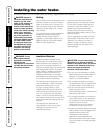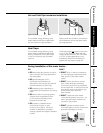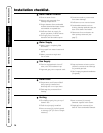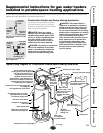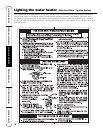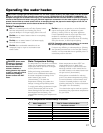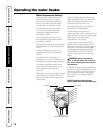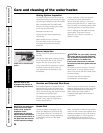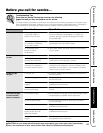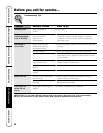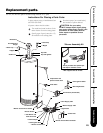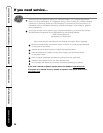
Customer Service Troubleshooting Tips Care and Cleaning Operating Instructions Installation Instructions Safety Instructions
Proper burner and pilot flame
pattern
20
Care and cleaning of the water heater.
Venting System Inspection
The water heater’s internal flue must be
inspected annually to be certain it is clean
by removing the draft hood and flue baffle.
When reinstalling the flue baffle make
certain it is hung securely by its hanger
at the top of the flue way.
Reinstall the draft hood.
Inspect the gas venting system and
the chimney.
Make certain the vent connector
from the draft hood to the chimney
is properly positioned and securely
attached.
If after inspection of the vent system
you found sooting or deterioration
call the local gas utility to correct the
problem and clean the flue, or replace the
flue, flue baffle, and venting system before
resuming operation of the water heater.
Test for spillage at the draft hood relief
opening after 5 minutes of burner
operation. Use a flame of a match or
candle or smoke.
NOTICE: Refer to the
Hydrogen Gas Caution in
the Operating Instructions.
Vacation and Extended Shut-Down
If the water heater is to remain idle for an
extended period of time, the power and
water to the appliance should be turned
off to conserve energy and prevent a build-
up of dangerous hydrogen gas.
The water heater and piping should be
drained if they might be subjected to
freezing temperatures.
After a long shut-down period, the water
heater’s operation and controls should be
checked by qualified service personnel.
Make certain the water heater is
completely filled again before placing it
in operation.
NOTICE: Do not remove the
anode rod from the water
heater’s tank, except for
inspection and/or
replacement, as operation
with the anode rod removed
will greatly shorten the life of
the glass lined tank and will
exclude warranty coverage.
Anode Rod
This water heater is equipped with an
anode rod designed to prolong the life
of the glass lined tank. The anode rod
is slowly consumed, thereby eliminating
or minimizing corrosion of the glass
lined tank.
Water sometimes contains a high sulfate
and/or mineral content and together with
cathodic protection process can produce
a hydrogen sulfide, or rotten egg odor in
the heated water. Chlorination of the
water supply should minimize the problem.
Burner Inspection
Visually inspect the pilot and main burners
annually.
Through the sight glass, inspect the pilot
burner flame with main burner off and
inspect the main burner while firing.
If any unusual burner operation is noted,
the water heater should be shut off
until qualified service assistance can
be obtained.
CAUTION:
For your safety, cleaning
of the main burner must be performed
only by qualified service personnel. The
burner chamber is a sealed area.
If the burner access door is removed,
the burner access door gasket must be
replaced.
For cleaning, remove the burner from the
water heater. A vacuum cleaner can be
used on the burner and floor shield inside
the water heater.
The burner can also be cleaned by
scrubbing with mild detergent.
!



